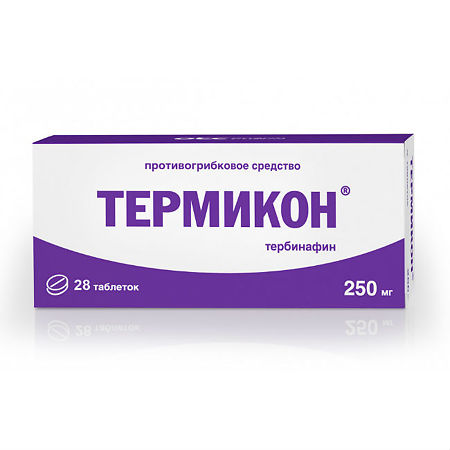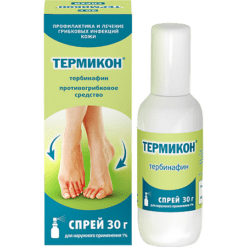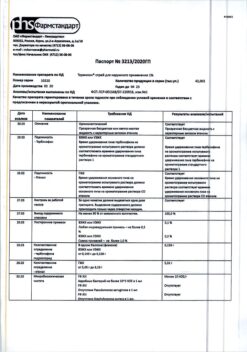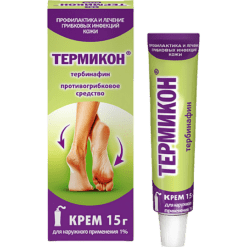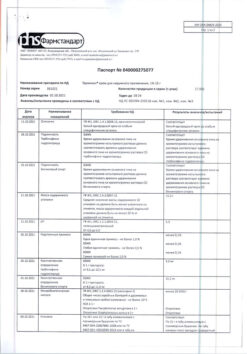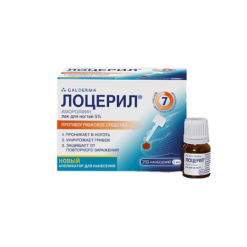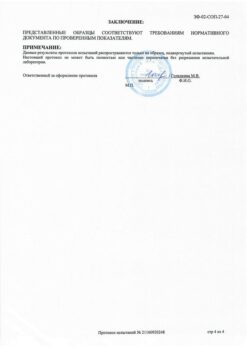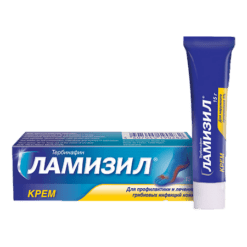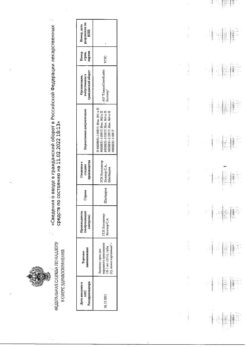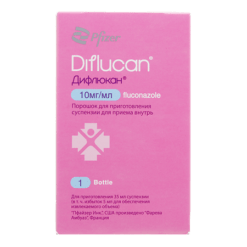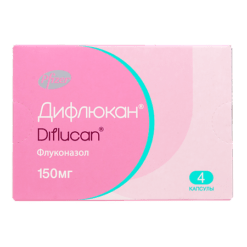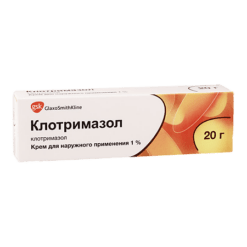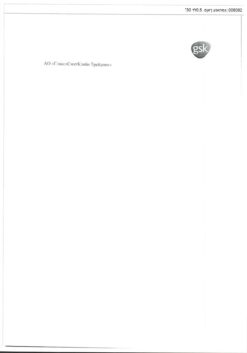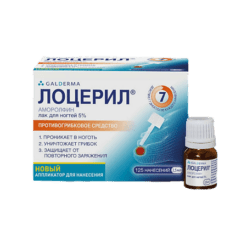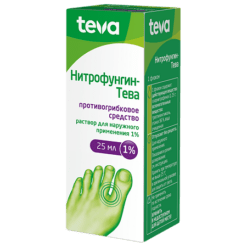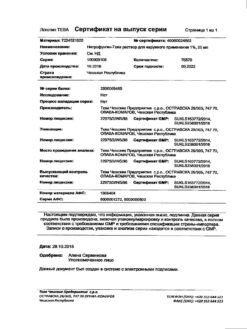No products in the cart.
Termicon, tablets 250 mg 28 pcs
€29.33 €24.44
Description
Pharmacotherapeutic group antifungal agent
ATC code D01BA02
Pharmacological properties
Pharmacodynamics:terbinafine belongs to the group of allilamines, has a wide range of antifungal action. At low concentrations it has a fungicidal effect on dermatophytes (T. rubrum, T. mentagrophytes, T. tonsurans,
T. verrucosum, T. violaceum), Microsporumcanis, Epidermophyton floccosum, molds (e.g. Aspergillus, Cladosporium, Scopulariopsisbrevicalius), yeasts, mainly Candidaalbicans, and some dimorphic fungi. Candida fungi and its mycelial forms have fungicidal or fungistatic effect depending on the fungus species.
Terbinafine disrupts the early stage of biosynthesis of the main component of the cell membrane of the fungus ergosterol by inhibiting the enzyme squalene epoxidase.
If administered orally, it is not effective in the treatment of variegated herpes caused by Malasseziafurfur.
Pharmacokinetics: Oral administration is well absorbed; half of the dose is absorbed after 0.8 hours; after 4.6 hours half of the dose is eliminated in the body. One to two hours after a single oral dose of 250 mg, maximum blood plasma concentration reaches 0.97 mcg/ml. Bioavailability is 80%. Food intake does not affect the bioavailability of terbinafine.
Terbinafine binds intensively with plasma proteins (99%), quickly spreads in the tissues, penetrates into the dermal layer of the skin and nail plates. It penetrates into the secretion of sebaceous glands and accumulates in high concentrations in hair follicles, hair, skin and subcutaneous tissue.
The elimination half-life is 16-18 h, the terminal phase elimination half-life is 200-400 h.
It is biotransformed in the liver to inactive metabolites; 80 % of the dose taken is excreted in the urine as metabolites, the rest (22 %) – in the faeces. It does not accumulate in the body. Age of patients does not affect the pharmacokinetics of terbinafine, however, elimination may be reduced with kidney or liver damage, leading to high concentrations of terbinafine in blood.
It is excreted with the breast milk.
Indications
Indications
Mycoses of the scalp (trichophytia, microsporia).
Mycoses of the skin and nails caused by Trychophyton (T. rubrum, mentagrophytes, verrucosum, violaceum), Microsporum (M. canis, M.gypseum) and Epidermophytonfloccosum.
Onychomycosis.
Severe, widespread dermatomycosis of smooth skin of the trunk and extremities, requiring systemic treatment.
Candidiasis of the skin and mucous membranes.
Pharmacological effect
Pharmacological effect
Pharmacotherapeutic group antifungal agent
ATX code D01BA02
Pharmacological properties
Pharmacodynamics: terbinafine belongs to the group of allylamines and has a wide spectrum of antifungal action. In low concentrations it has a fungicidal effect on dermatophytesTrychophyton (T. rubrum, T. mentagrophytes, T. tonsurans,
T. verrucosum, T. violaceum), Microsporumcanis, Epidermophytonfloccosum, molds (eg Aspergillus, Cladosporium, Scopulariopsisbrevicalius), yeasts, mainly Candida albicans, and some dimorphic fungi. Depending on the type of fungus, it has a fungicidal or fungistatic effect on Candida fungi and its mycelial forms.
Terbinafine disrupts the early stage of biosynthesis of the main component of the cell membrane of the fungus, ergosterol, by inhibiting the enzyme squalene epoxidase.
When administered orally, it is not effective in the treatment of pityriasis versicolor caused by Malassezia furfur.
Pharmacokinetics: when taken orally, it is well absorbed, after 0.8 hours half of the dose taken is absorbed; after 4.6 hours, half of the dose taken is distributed in the body. 1-2 hours after oral administration of a single 250 mg dose, the maximum concentration of the drug in the blood plasma reaches 0.97 mcg/ml. Bioavailability 80%. Food intake does not affect the bioavailability of terbinafine.
Terbinafine intensively binds to plasma proteins (99%), quickly distributes in tissues, penetrates the dermal layer of the skin and nail plates. Penetrates the secretion of the sebaceous glands and accumulates in high concentrations in the hair follicles, hair, skin and subcutaneous tissue.
The half-life is 16-18 hours, the half-life of the terminal phase is 200-400 hours.
Biotransformed in the liver to inactive metabolites; 80% of the dose taken is excreted in the urine in the form of metabolites, the rest (22%) in feces. Does not accumulate in the body. The age of patients does not affect the pharmacokinetics of terbinafine, however, elimination may be reduced in cases of kidney or liver damage, leading to high concentrations of terbinafine in the blood.
It is excreted in breast milk.
Special instructions
Special instructions
Irregular use of terbinafine or premature cessation of treatment may lead to relapse of the disease.
The duration of therapy may be influenced by factors such as the presence of concomitant diseases and the condition of the nails at the beginning of the course of treatment.
If after 2 weeks of treatment there is no improvement in the condition, it is necessary to re-determine the causative agent of the disease and its sensitivity to the drug.
Systemic use for onychomycosis is justified only in the case of total damage to most nails, the presence of severe subungual hyperkeratosis, and the ineffectiveness of previous local therapy.
When treating onychomycosis, a clinical response is usually observed several months after mycological cure and cessation of treatment, which is due to the rate of regrowth of a healthy nail. Removal of nail plates is not required when treating onychomycosis of the hands for 3 weeks and onychomycosis of the feet for 6 weeks.
In the presence of severe renal failure (creatinine clearance less than 50 ml/min or blood creatinine more than 300 µmol/l), if liver function is impaired, the dose of terbinafine should be halved.
In the presence of liver disease, the clearance of terbinafine may be reduced.
For reduced liver function, half the adult dose is prescribed.
Before starting the use of terbinafine tablets, it is necessary to conduct a liver function test. Hepatotoxicity can occur in patients with or without pre-existing liver disease.
During therapy, periodic liver function testing is recommended (4-6 weeks after the start of treatment). Treatment with terbinafine should be stopped immediately if liver function tests increase.
Patients prescribed terbinafine should be warned that it is necessary to immediately inform the attending physician if symptoms such as persistent nausea, decreased appetite, fatigue, vomiting, pain in the right hypochondrium, jaundice, dark urine or light-colored feces occur while taking the drug.
If such symptoms occur, you should immediately stop taking the drug and conduct a liver function test.
Serious skin reactions (including Stevens-Johnson syndrome, toxic epidermal necrolysis, drug rash with eosinophilia and systemic symptoms) have been reported extremely rarely with terbinafine.
Prescribing terbinafine to patients with psoriasis requires increased caution, because In very rare cases, terbinafine can trigger a psoriasis flare-up.
When using terbinafine tablets, extremely rare cases of changes in the cellular composition of the blood (neutropenia, agranulocytosis, thrombocytopenia, pancytopenia) were observed. If qualitative or quantitative changes in blood cells develop, the cause of the disturbances should be established and consideration should be given to reducing the dose of the drug or, if necessary, discontinuing terbinafine therapy.
Terbinafine has been shown to inhibit isoenzyme 2D6 (CYP2D6)-mediated metabolism.
Therefore, it is necessary to carry out constant monitoring of patients receiving concomitant treatment with terbinafine with drugs that are predominantly metabolized with the participation of this enzyme (such as tricyclic antidepressants, beta-blockers, selective serotonin reuptake inhibitors, class IC antiarrhythmic drugs and monoamine oxidase B inhibitors) if the drug used simultaneously has a small therapeutic concentration range.
When treating with terbinafine, general hygiene rules should be observed to prevent the possibility of re-infection through underwear and shoes. During treatment (after 2 weeks) and at the end, it is necessary to carry out antifungal treatment of shoes, socks and stockings.
Impact on the ability to drive vehicles and machinery
The effect of terbinafine on the ability to drive vehicles and operate machinery has not been studied. If dizziness develops during drug therapy, patients should not drive vehicles and/or operate machinery.
Active ingredient
Active ingredient
Terbinafine
Composition
Composition
Active substance:
Terbinafine hydrochloride – 281.25 mg (in terms of terbinafine – 250 mg)
Excipients:
croscarmellose sodium – 48 mg,
microcrystalline cellulose – 35.2 mg,
lactose monohydrate – 23.95 mg,
hypromellose (hydroxypropyl methylcellulose) – 6.2 mg,
magnesium stearate for the pharmaceutical industry – 4 mg,
colloidal silicon dioxide (Aerosil) – 1.4 mg.
Pregnancy
Pregnancy
Data from experimental studies do not suggest the presence of adverse effects on fertility and toxic effects on the fetus. Since clinical experience with terbinafine in pregnant women is very limited, the drug should not be used during pregnancy unless the expected benefit of therapy outweighs the potential risk to the fetus.
Terbinafine is excreted in breast milk, so women receiving terbinafine by mouth should not breast-feed.
Contraindications
Contraindications
Hypersensitivity to terbinafine or to any other component of the drug; children under 3 years of age and with a body weight of up to 20 kg (for this dosage form).
Severe, chronic or active liver disease.
It is not recommended to use terbinafine in patients with impaired renal function (creatinine clearance less than 50 ml/min or serum creatinine concentration more than 300 µmol/l), since the use of the drug in this category of patients has not been sufficiently studied.
With caution
Liver dysfunction, suppression of bone marrow hematopoiesis, cutaneous lupus erythematosus or systemic lupus erythematosus, psoriasis.
Side Effects
Side Effects
Thermikon® was generally well tolerated. Side effects are usually mild or moderate and transient.
When assessing the frequency of occurrence of side effects of a drug, the following gradations were used: “very often” (≥1/10), “often” (from ≥1/100 <1/10), “infrequently” (≥1/1000 <1/100), “rarely” (≥1/10000 <1/1000), “very rarely” (<1/10000), including individual reports.
Disorders of the blood and lymphatic system: infrequently – anemia; very rarely – neutropenia, agranulocytosis, pancytopenia, thrombocytopenia.
Immune system disorders: very rarely – anaphylactoid reactions (including angioedema), cutaneous and systemic lupus erythematosus (or their exacerbation).
Mental disorders: often – depression; infrequently – anxiety.
Nervous system disorders: very often – headache; often dizziness, disturbance of taste, up to their loss (usually recovery occurs within a few weeks after stopping treatment). In some cases, exhaustion was observed while taking terbinafine. There are isolated reports of cases of long-term disturbances of taste; infrequently – paresthesia, hypoesthesia.
Visual disturbances: infrequently – visual disturbances.
Hearing and labyrinthine disorders: uncommon – tinnitus.
Disorders of the liver and biliary tract: rarely – hepatobiliary dysfunction (mainly of cholestatic nature), incl. liver failure, including very rare cases of severe liver failure (some fatal or requiring liver transplantation; in most cases where liver failure developed, patients had serious concomitant systemic diseases and the causal relationship of liver failure with terbinafine was questionable), hepatitis, jaundice, cholestasis, increased activity of liver enzymes.
Disorders of the digestive system: very often – bloating, loss of appetite, dyspepsia, nausea, mild abdominal pain, diarrhea.
Disorders of the skin and subcutaneous tissues: very often – rash, urticaria; uncommon – photosensitivity reactions; very rarely – Stevens-Johnson syndrome, toxic epidermal necrolysis, acute generalized exanthematous pustulosis, erythema multiforme, toxic skin rash, exfoliative dermatitis, bullous dermatitis, psoriasis-like skin rashes or exacerbations of psoriasis, alopecia.
Musculoskeletal and connective tissue disorders: very common: arthralgia, myalgia.
General disorders: often – feeling of fatigue; uncommon – increased body temperature.
Laboratory and instrumental data: infrequently – weight loss (secondary to a disturbance in the sense of taste).
Based on spontaneous reports received during the post-registration period and literature data, the following adverse events were identified, the frequency of which, due to the inaccurate number of patients, cannot be established.
Immune system disorders: anaphylactic reactions, serum sickness-like syndrome.
Visual disorders: visual impairment.
Skin and subcutaneous tissue disorders: drug rash with eosinophilia and systemic symptoms (rash, swelling, fever and swollen lymph nodes).
Hearing and labyrinthine disorders: hearing loss, hearing impairment.
Vascular disorders: vasculitis.
Nervous system disorders: loss of smell, including for a long period of time, decreased sense of smell.
Digestive system disorders: pancreatitis.
Musculoskeletal and connective tissue disorders: rhabdomyolysis.
General disorders: influenza-like syndrome.
Laboratory and instrumental data: increased activity of creatine phosphokinase in the blood serum.
If you notice any side effects of the drug,
Tell your doctor about this.
Interaction
Interaction
Inhibits the CYP2D6 isoenzyme and interferes with the metabolism of drugs such as tricyclic antidepressants and selective serotonin uptake blockers (eg Desipramine, fluvoxamine), β1-blockers (metoprolol, propranolol), antiarrhythmics (flecainide, propafenone), MAO-B inhibitor (selegiline) and antipsychotics (eg chlorpromazine, haloperidol).
Drugs that are inducers of CYP450 enzymes (eg rifampicin) can accelerate the elimination of terbinafine from the body.
Medicines that are CYP450 inhibitors (eg cimetidine) may slow down the metabolism and elimination of terbinafine from the body. If these drugs are used concomitantly, a dose adjustment of terbinafine may be required.
Menstrual irregularities are possible when taking terbinafine and oral contraceptives simultaneously.
Reduces caffeine clearance by 21% and prolongs its half-life by 31%.
Does not affect the clearance of phenazone, digoxin, warfarin.
When used together with ethanol or drugs,
having a hepatotoxic effect, there is a risk of developing drug
liver damage.
Overdose
Overdose
Symptoms: nausea, vomiting, pain in the lower abdomen, in the epigastric region.
Treatment: gastric lavage followed by the administration of activated charcoal and/or symptomatic therapy.
Storage conditions
Storage conditions
Store in a dry place, protected from light, out of reach of children.
Shelf life
Shelf life
4
year. Do not use after the expiration date stated on the package.
Manufacturer
Manufacturer
Pharmstandard-Leksredstva, Russia
Additional information
| Shelf life | 4 years. Do not use after the expiration date printed on the package. |
|---|---|
| Conditions of storage | Store in a dry, protected from light, out of the reach of children. |
| Manufacturer | Pharmstandard-Leksredstva, Russia |
| Medication form | pills |
| Brand | Pharmstandard-Leksredstva |
Other forms…
Related products
Buy Termicon, tablets 250 mg 28 pcs with delivery to USA, UK, Europe and over 120 other countries.

